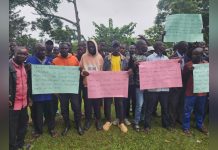Africa-Press – Uganda. The economic impact of the Covid-19 pandemic and school closures have continued to push children into hazardous forms of child labour. Child labour remains rife in the agriculture sector, notably in the tea value chain, one of Uganda’s key cash crops.
One recent Friday afternoon at a sprawling tea estate in Hoima District, western Uganda, children hover around tin-roofed shanty houses that dot the five-square kilometer tea plantation. Known as labour villages, children, and their parents are all workers, spending countless hours each day of the week to pick tea leaves.
Ten-year-old John Opio lives in the estate with his father and mother. Since the closure of schools he usually tags along with his parents to work at the tea plantation.
“I accompany my mom to the plantation to pick the tea every morning,” he says “ I don’t have anyone to stay with at home since we are not going to school anymore”
Tea is one of Uganda’s leading exports. Uganda’s tea industry is booming with exports averaging 65,000 metric tons annually, worth $120 million.
Child labour refers to children aged 5-11 years engaged in any economic activity; or children aged 12-13 years doing work other than light work ‟or do work beyond 14 hours a week”; or children aged 14-17 years involved in hazardous forms of labour or working for an equivalent of 43 hours in a week or beyond.
Several laws in Uganda prohibit the employment of children. Uganda’s Child Labour Policy, 2006, the National Employment Policy, 2011, the Employment Act, 2006, the Occupational Safety and Health Act, 2006, and Employment Regulations, 2011 all have provisions prohibiting child labour. But what’s happening in the country’s tea industry shows a different story.
Anthony Ayesiga the Hoima district labour officer acknowledges that child labour is prevalent on the tea plantations and among out growers, especially during the peak harvesting season.
“The Covid-19 pandemic has pushed more children into plantations, most of these end up working on the tea plantations for a living.”
Most of their parents are not sensitized about child labour and look at children as part of the family unit that must work and contribute to the family, Mr Ayesiga explains.
Ayesiga says that the district leadership has put in place community bylaws which are interpreted for communities and has been sensitizing the communities about child labour through radio talkshows and programmes. These bylaws require parents to keep their children in school or at home. Some parents who let their children work on plantations are arrested.
In May, President Museveni launched the Second National Action Plan on the Elimination of Child Labour 2020/2021 – 2024/2025, demonstrating a strong policy commitment at the highest level.
The objective of the National action plan is to eliminate the worst forms of child labour and at the same time lay a firm foundation for children’s rights to be respected, protected and fulfilled.
International Labour Organization under its Accelerating Action for the Elimination of Child Labour in Supply Chains in Africa project addresses child labour in selected supply chains in Côte d’Ivoire, Egypt, Malawi, Mali, Nigeria, and Uganda with focus on some of the most widely traded agricultural commodities including cocoa, coffee, cotton, tea, and gold.
The Uganda National Household Survey 2019/20 indicates that there’s been a 28 per cent increase in child labour incidences countrywide.
The loss of incomes, livelihoods, combined with school closures due to Covid-19 pandemic contributed to increased child labour as more children have been forced to enter the workforce in order to help their families survive.
Ms Diana Taremwa Karakire is a consultant with the International Labour Organisa tion under ACCEL Africa Project.






